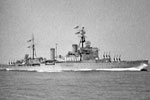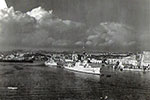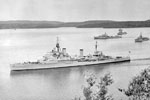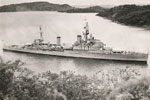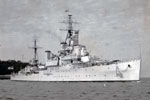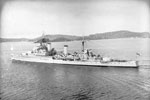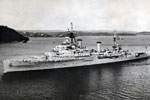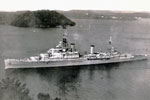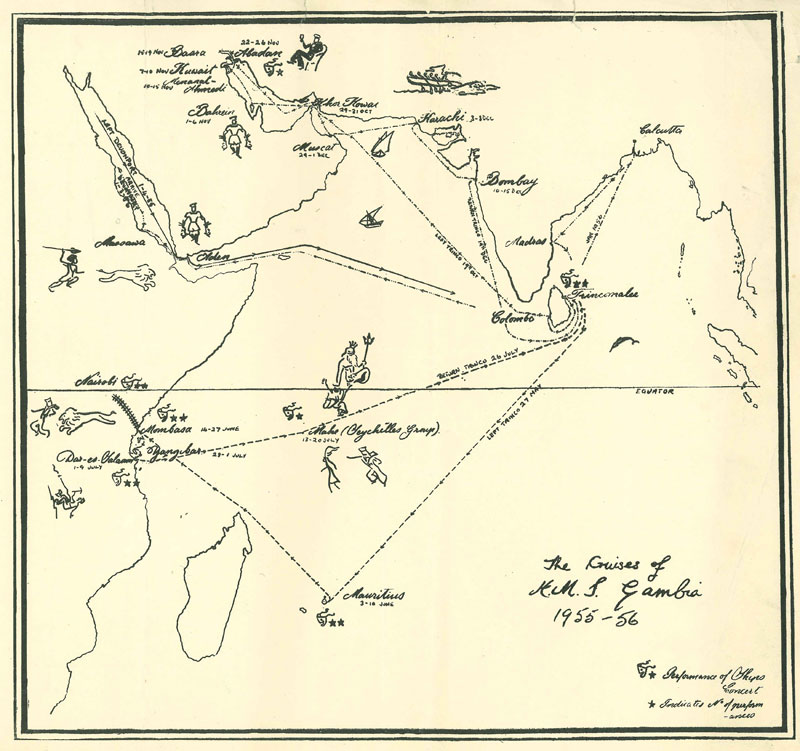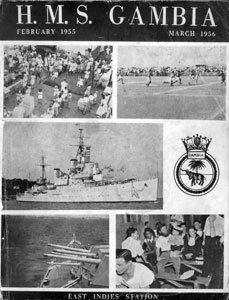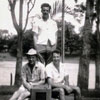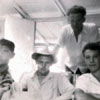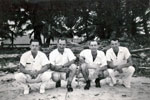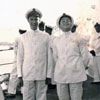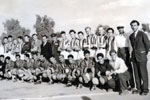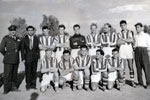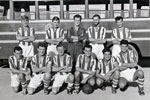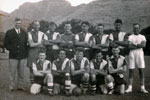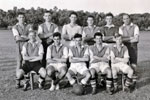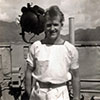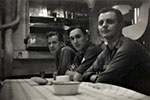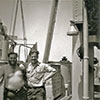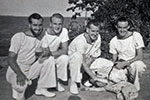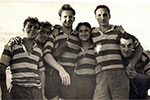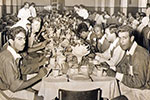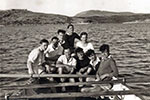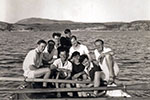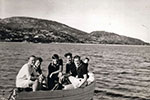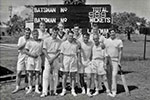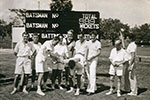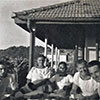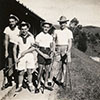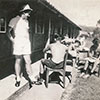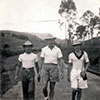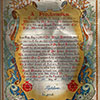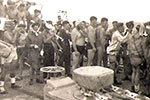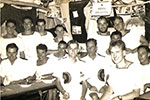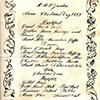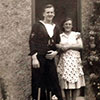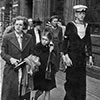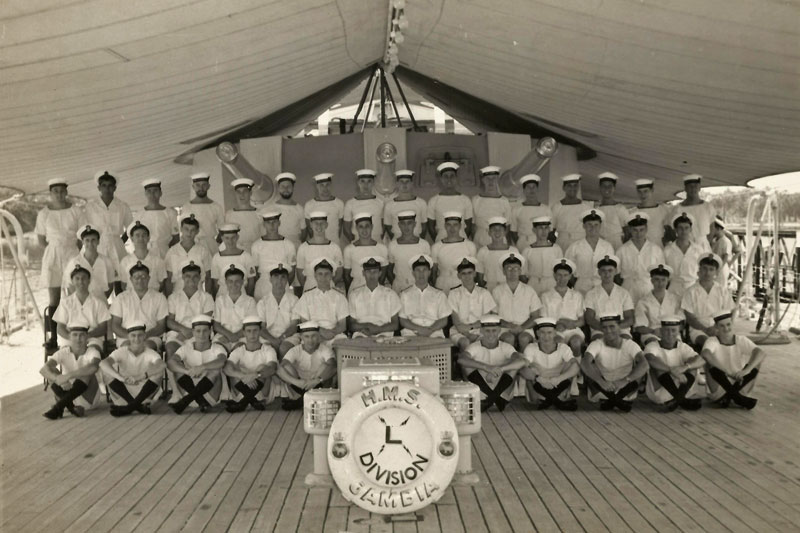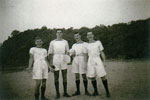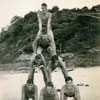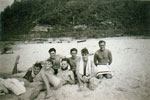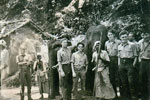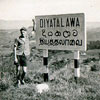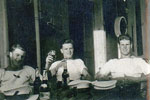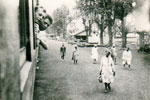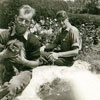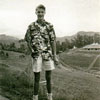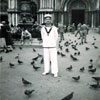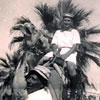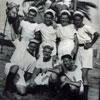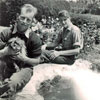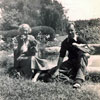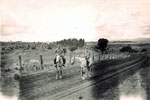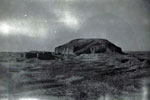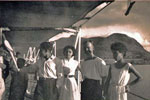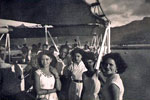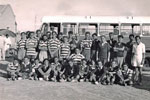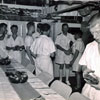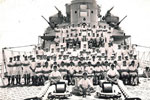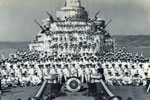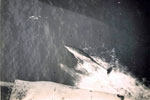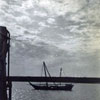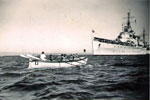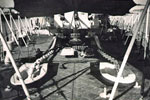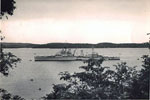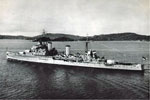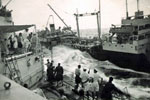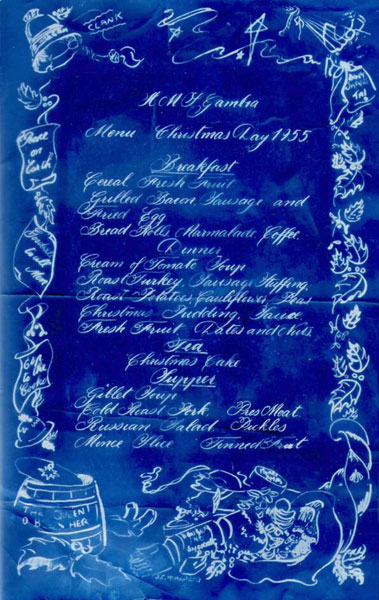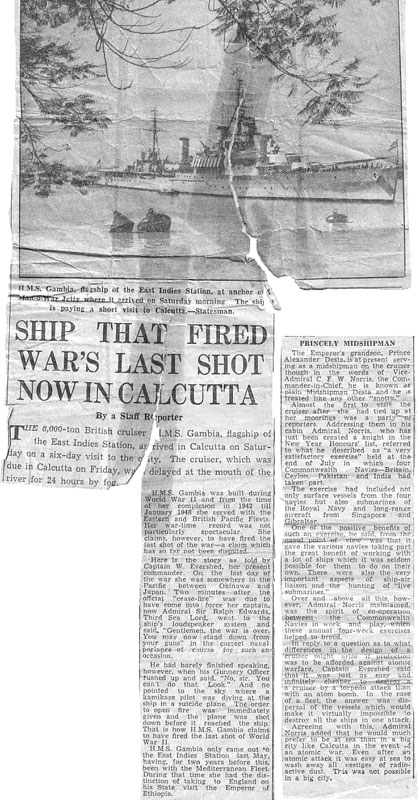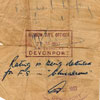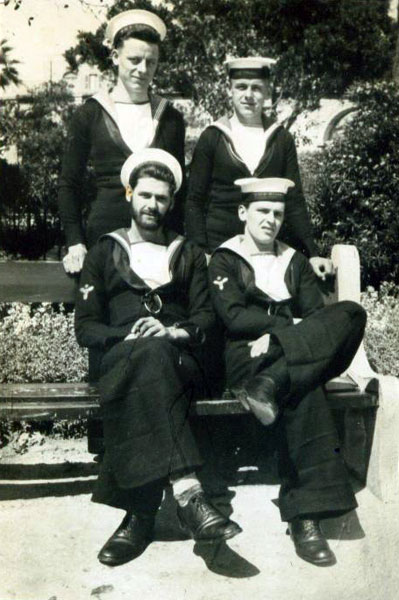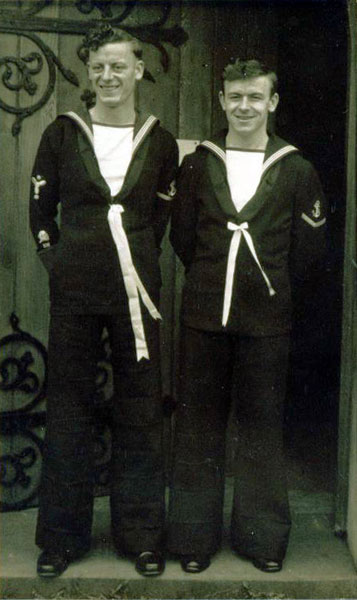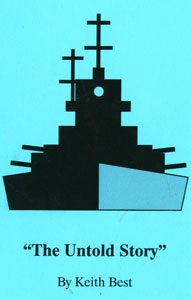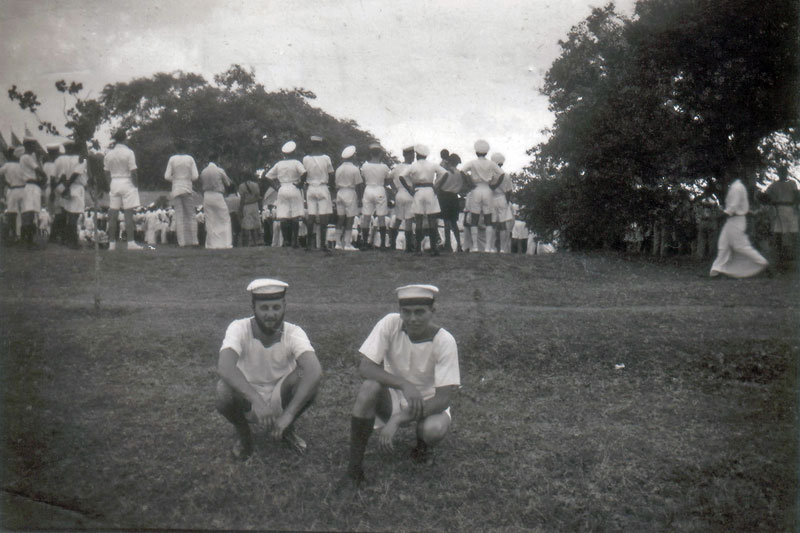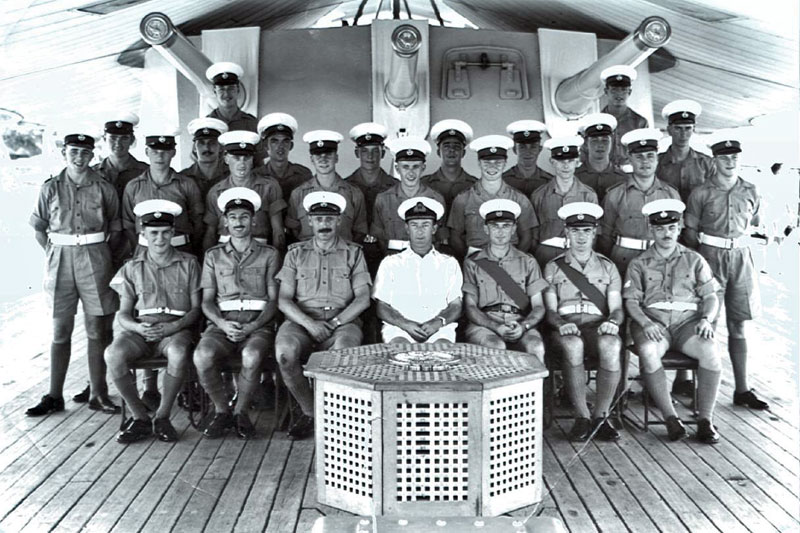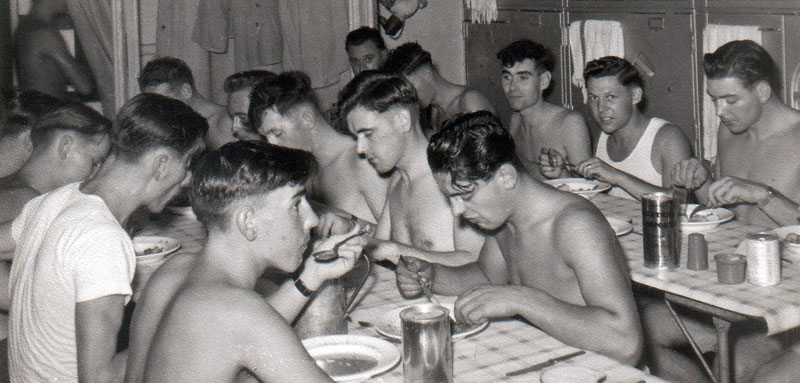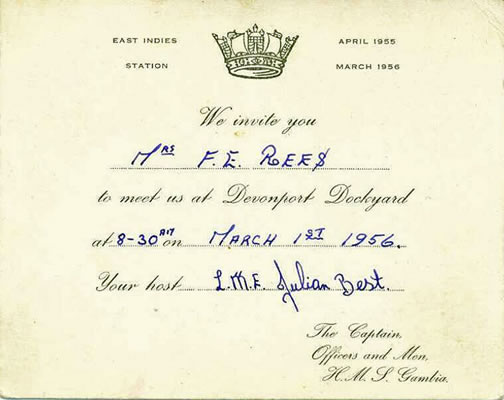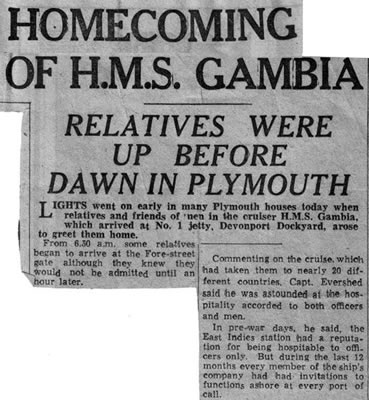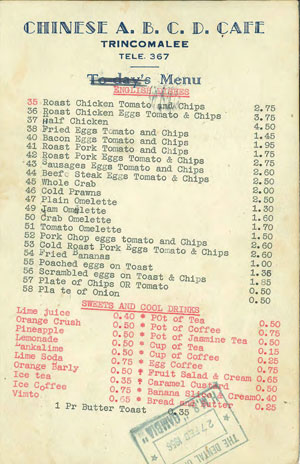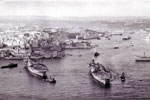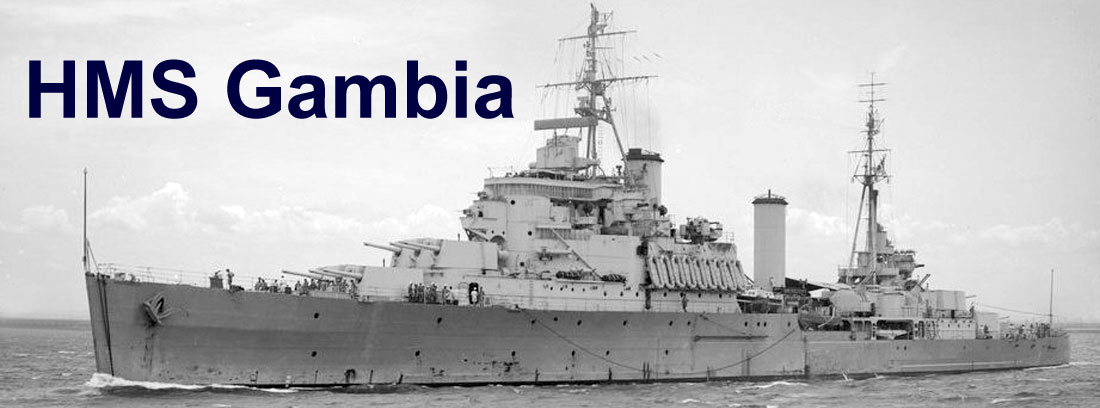
The 1955 to 1956 Commission
For this commission HMS Gambia was the flagship of Vice Admiral C. F. W. Norris, C.B., D.S.O., Commander-in-Chief, East Indies Station based on Trincomalee. Her commander was Captain W. Evershed D.S.O., R.N. After leaving Devonport, the ship visited Gibraltar, Malta, Mauritius, East Africa, the Persian Golf, Pakistan and India.
The original departure date from Devonport was set to be in March 1955, but had to be delayed for several weeks because of an engine defect. Her next port of call was Gibraltar and then on to Grand Harbour, Malta which she reached on Good Friday which was April 8, 1955. She didn't stay long and left on Easter Monday (April 11) for the port of Marsaxlokk, around which gunnery practice took place. The ship left Malta on April 21, heading for Trincomalee, Sri Lanka (then named Ceylon) which they reached on May 17. Then, crossing the equator with the usual ceremonies, on to Port Louis on Mauritius in the Indian Ocean, where the crew took part in the Queen's Birthday Parade in June.
On June 14, 1955, the ship arrived in Kilindini harbour, Mombasa, Kenya. On June 21, they were visited by a group of children from the Mombasa European Primary School (MEPS). Gambia stayed at Mombasa for two weeks, leaving on June 27. After this they stopped at Zanzibar where they played host to the Sultan, Khalifa bin Harub. Then on to Dar-es-Salaam, Tanzania which they reached on July 1. On July 4, at least some of the crew enjoyed a brewery run. From Tanzania they left for Victoria, the capital city of Seychelles.
Gambia then recrossed the equator back to Trincomalee, Sri Lanka for the month long Exercise JET (Joint Exercises, Trincomalee). During the exercise Gambia practiced replenishment at sea and the defense of coastal and ocean convoys.
By now summer had gone and on October 19, Gambia left Trincomalee heading for Colombo, Sri Lanka, the first stage of a cruise to the Persian Gulf, Pakistan and India. They spent two days at Colombo before sailing for Khor Kuwai, Oman which took a week. Only stopping just for a day, they were off to Bahrain, then Kuwait and then on to Mena al Ahmadi.
On November 14, they left Mena for the Shatt al-Arab river, Iraq where they reached Basrah. On November 19 they were steaming back down the river for Khorramshar, Iran and then on to Abadan, Iran. On to Muscat, Oman. From there it was on to Karachi, the capital of Pakistan. from there to Bombay, India.
They left India on December 15, to head back to Trincomalee, Sri Lanka for Christmas and the New Year. After that break it was off again to Calcutta and Madras, India and then Massawa in Eritrea before returning back to the UK.
The above map was very kindly donated by Janet Kirkham, niece of Sick Berth Attendant Kenneth George Griffin.
The little details whoever drew the map added are amusing:
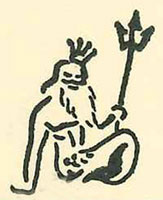
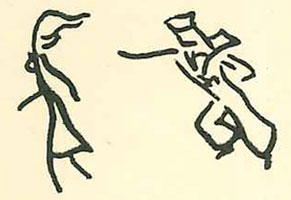

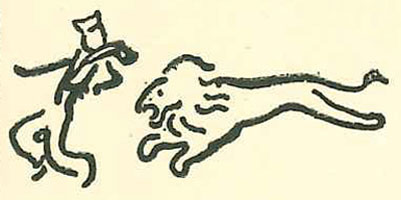
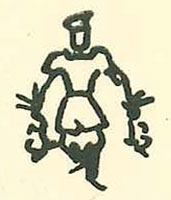
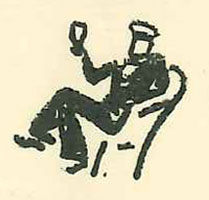
Janet also sent a copy of the February 1955 to March 1956 Commissioning Book. This is available as a PDF file (3Mb)
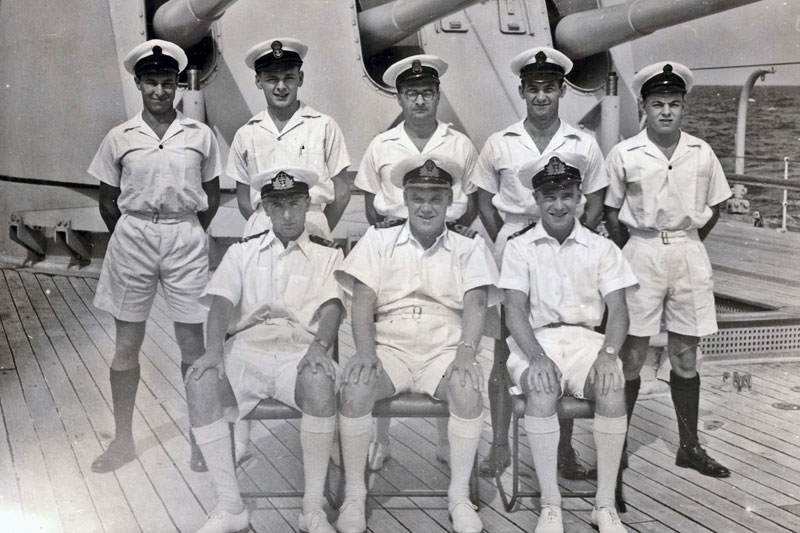
Above and below: The Medical Team on HMS Gambia during the 1955/6 Commission
They would have included Surgeon Commander W. Wilson, Surgeon Lieutenant J. V. Deakin, Surgeon Lieutenant (D) A. Moore, Sick Berth Chief Petty Officer D. H. Shears, Sick Berth Petty Officer T. C. G. O'Hagan, Sick Berth Attendants L. Goodier, K. G. Griffin and W. Halliman
The pictures were very kindly submitted by Janet Kirkham, niece of Sick Berth Attendant Ken Griffin
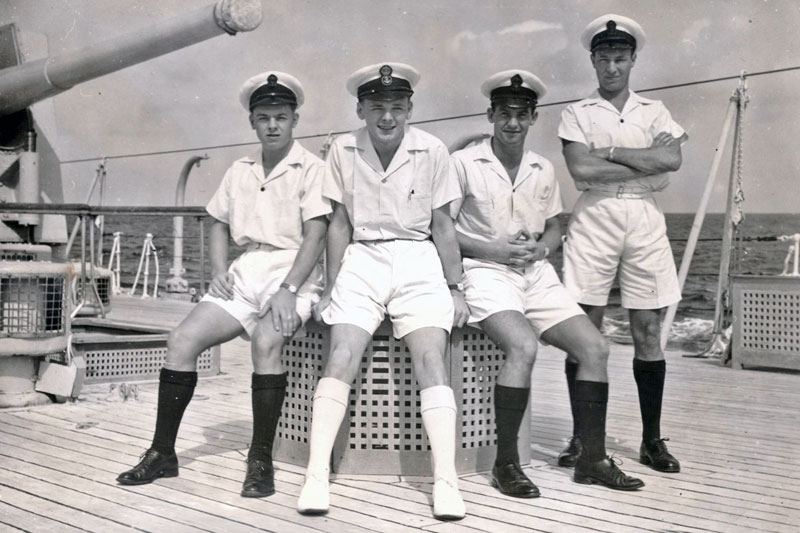

Ken Griffin? doesn't appear to be enjoying the rough shave given during the "Crossing the Line" ceremony
Another picture kindly submitted by Janet Kirkham, niece of Sick Berth Attendant Ken Griffin
In March 2020, Amanda Dalton, the daughter of Leading Telegraphist John William Holmes Aire who served on HMS Gambia for her 1955/56 commission, very kindly sent me a lot of photos and a biography.
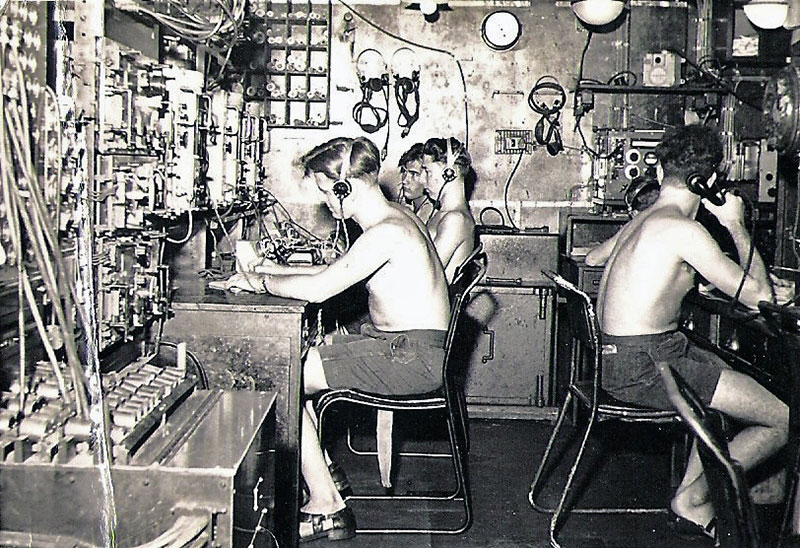
Leading Telegraphist John "Jock" Aire on left front, Ordinary Telegraphist Harold Geoff Beestin, Telegraphist G. "Jock" Redpath. Front right, holding the phone is the leading hand of the watch, who is anonymous, looking at the back of the head of Ordinary Telegraphist Nev Blockley.
Amanda wrote of her father...
My Dad, John William Holmes Aire (Jock/Jackie) was born in Glasgow on the 21st May 1932. He was orphaned in 1941 and joined the Royal Navy (RN) in June 1948 as a boy telegraphist. He remained at the shore establishment HMS Ganges until September 1949. I know that he was involved in the manning the mast ceremony at some point during his time there. He transferred to Devonport (HMS Drake) in September of that year.
His first shipboard posting was HMS Euryalus (a Dido-class cruiser) in October 1949 as an ordinary telegraphist. He then went on to serve on HMS Tyne (a Hecla-class destroyer depot ship) in Malta on January 1951 for a year. He returned to Devonport for 4 months before joining HMS Flint Castle (a Castle-class corvette) based at HMS Osprey (Portland) from May 1952 until January 1953. He returned to HMS Drake in January 1953 and on to another shore establishment HMS Hornet (Gosport) July of the same year. During this time I think Dad also spent time on HMS Porchester Castle (another Castle-class corvette, HMS Loch Scavaig (a Loch-class frigate) and at HMS Hornet, HMS Gifford, a Ford-class Seaward defence patrol boat.
In November 1953 he was promoted to a leading telegraphist and joined HMS Gambia in January 1955 for the 1955-56 commission. He was put in charge of cryptographic duties whilst serving on the Gambia. He returned to HMS Drake at the end of that commission and married my Mum, Pearl Ivy Lough on the 29 December 1956. His Royal Navy service culminated as i/c of CRR at RNAS Yeovilton (HMS Heron) on the 28 March 1957.
During his time in the RN he was an active and enthusiastic sportsman, representing his ship/division/mess in football, rugby, cricket, swimming and rowing. He also took part in the Royal Navy Field Gun competition representing Devonport.
He joined the Mid Anglia Constabulary (now Cambridgeshire police) in June 1957 serving in uniform and subsequently in the CID and as a Scenes of Crime Officer. He left the force in October 1966 and became a private detective and subsequently worked for several firms of Solicitors in Peterborough as a legal executive. He died in February 1978 at the very young age of 45.

HMS Gambia's Communications Division.
Leading Telegraphist John Aire is third row, 8th from the left.
Petty Officer Telegraphist S. "Tubby" Jackson is 2nd row, 11th from left.
Ordinary Telegraphist Nev Blockley is front row, 6th from left.
Carol, the daughter of AB Ernest C. R. Shirley sent this photograph to Bill...
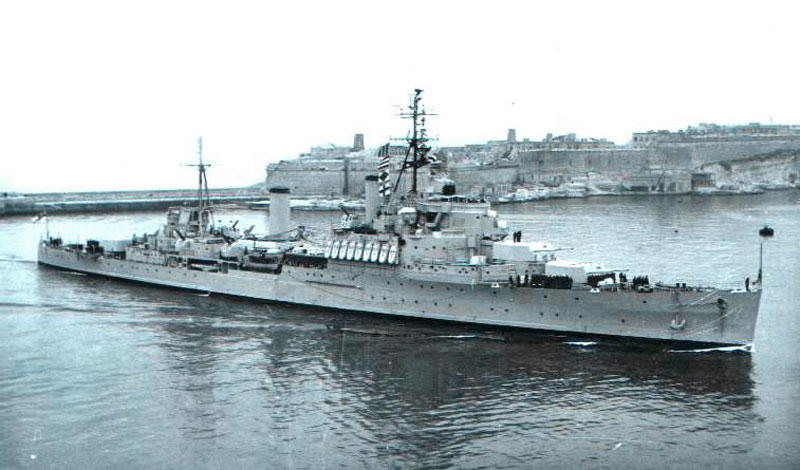
HMS Gambia entering Grand Harbour, Malta in April 1955
Carol also sent this photo of her father, AB Ernest C. R. Shirley.
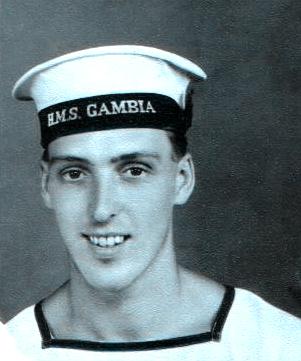
Ken Lobb served on HMS Gambia's 1955/56 Commission as a Lieutenant Commander (Lt. Cdr.). Ken passed away in 2014 aged 91 after retiring as Senior Captain ADC in the seventies.
Ken's son, Andrew, has very kindly sent some information and photos about his life and some of the 100 or so letters he wrote home to his wife Vera.
Born in Falmouth 1921, Cornwall, he grew up in South-East London and was educated principally at Eltham College (1933-40) He joined Standard Telephones and Cables initially at Woolwich as a telecommunications engineering student, later at Leicester (1941-2) Called up for the Navy, he was selected for technical training and later commissioned Temporary Sub-Lieutenant (Air) RNVR (1945), and Lieutenant RN (1946). Following qualifying courses, he held appointments on Flag Officer (Air's) staff and on the development and flight trials of the first fully stabilized Naval fixed-wing airborne radar.
Ken realized in the mid-fifties that in order to progress in rank he needed sea experience. He worked on radar during the last year of the war and was an electronics expert. Later, he was stationed in Lossiemouth with an interesting interlude involving the Torrey Canyon. He went on to be involved in the development of the Sea Lynx helicopter worked away from Portsmouth in London every week. He ended up as Deputy Principal at the Underwater Weapons Establishment on Portland working on torpedoes. The main man was a civil servant. He was consequently promoted Lieutenant Commander in 1954, his appointment included; HMS Gambia, in the Persian Gulf and Indian Ocean; development and trials of the all-weather Automatic Flight Control System for the Wessex helicopter.
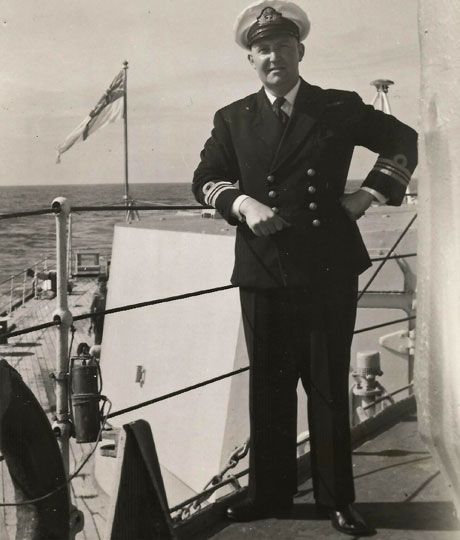
Ken Lobb in in the Mediterranean, April 1955 and January 1956
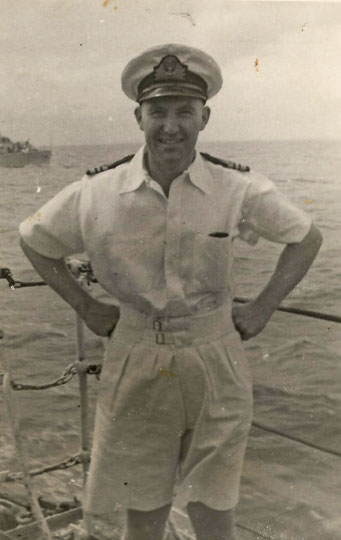
HMS Gambia at Trincomalee, Sri Lanka in late August 1955 after a Joint Exercises at Trincomalee (JET). Photo kindly submitted by Andrew Lobb
"L" Division of HMS Gambia on January 31, 1956. Photo kindly submitted by Andrew Lobb
The following image of HMS Gambia was on Bill's original page. I don't know where it came from but there was a note saying that it might have been taken in Malta.
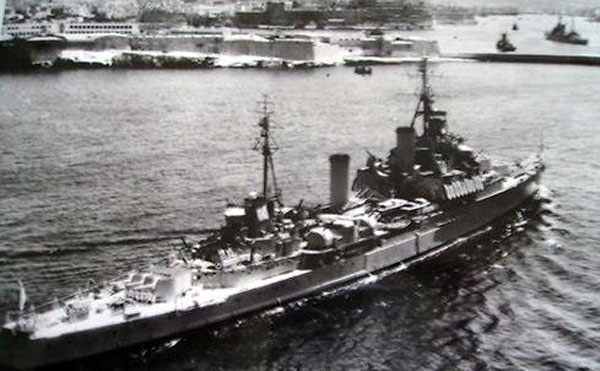
Below: Warships in Sliema Creek, Malta.

This photo is from Stephen Bentley and is mostly of the Electrical Branch. It was taken in the British Club in Abadan, Iran, just up the river North of the Persian Gulf in early November, 1955. Steve is on the extreme right at front and says that we had to be off the streets by 12 midnight otherwise you would be shot (curfew). Most of the British out there were Scots oil rig engineers.
Kuwait further South was only a sleepy city in those days. The Arabs built a freeway right out in the desert going nowhere just so they could drive their Cadillacs.
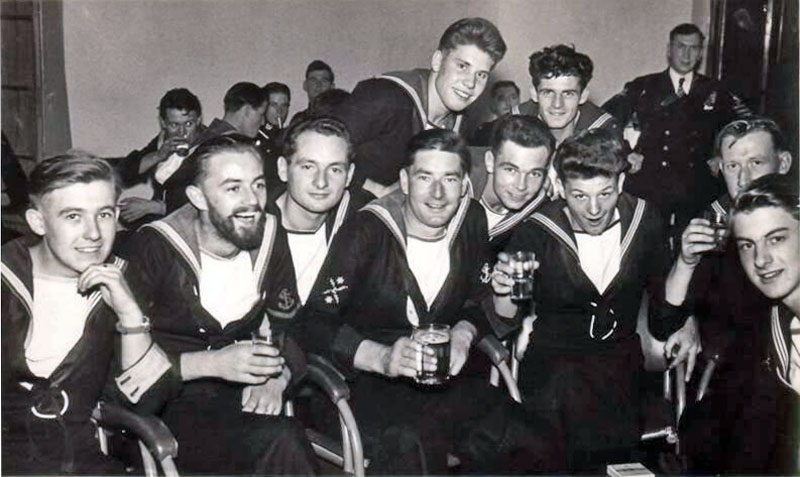
From the left: Electrical Mechanic, E. Duncan; Lewis; ?; Leading Electrical Mechanic, R. Percy Lavelle; ?; Electrical Mechanic, D. Pritchard; Electrical Mechanic, A. N. Hendry; Electrical Mechanic, Steve D. Bentley.
According to the Commission Book there were several Lewis's on this commission, but it seems most likely that the Lewis in the picture is Leading Electrical Mechanic, T. A. Lewis.
Steve joined the Gambia in November 1954, and said, "being in the electrical Branch, we had the overhaul & repair the DC Fan motors of which there were 140 on board. The cockroaches were in plenty - they got in your soup and hammocks. However in 1956, every Naval ship was fumigated, and we never saw any after that.

Grand Hotel in Calcutta, January 1956. Steve emailed me saying "I am standing second from left. The tall person at the rear is wearing my naval cap. To the right of him, is a civilian river pilot - who pilots the ships up & down the Hoogly river which is about 40+ miles from the sea. This pilot was Danish. The photo was taken on a Monday because the bar shut down at midnight, as Tuesday was a "dry" day (no booze) in Calcutta.
On the subject of bars closing. At the famous Mount Nelson Hotel in Cape Town (I have stayed there)......the bar closes at 2 pm. the reason being is that the Lady guests don't want their husbands drinking all afternoon, because the ladies like some attention themselves in the afternoons! The hotel's Afternoon Tea at 4pm is also famous - the 'spread on the table is fantastic and the decor is second to none, with a grand piano playing in the background."
I am indebted to Steve for providing copies of the following images after I failed to retrieve them from the Web Archive.
Power Failure in Trincomalee Harbour, Ceylon, 1955
Stephen contributed this story:
I was the switchboard watch keeper for a 3 months stint - there were four of us. Two of which did 24 hrs. 4hrs 'on' & 4hrs' off' then we had a day off whilst the other two took over the next day and so on. The switch board watch keeper had to receive calls for power to various equipment. plus to keep the voltage at the 220 volt DC, as this would vary depending on the electrical load. We had to record "findings" in the log every half hour.
One morning on my fore-noon watch around 1040hrs (probably some time on October), one generator's volts started to fall rapidly - I went to try and boost up the volts on the regulator - within seconds the other generator's volts dropped, and then a complete blackout. The ships telephone exchange was also in the switchboard room but in a sub-compartment, I then heard the phones ringing in excess. After about 5mins., my divisional electrical officer came down; the Lt. Commander K. Lobb. He looked at the switchboard log and found that there was no entry at 1030 hrs. - for once in all time, I had missed writing the details! Anyway, Commander Lobb had strong words for me but did not take it any further, which on some ships, I would be under punishment.
The reason why the power failed is that: At a certain time of the year, thousands of jelly fish come into the harbor to breed, and being so many, quite a few made their way into the sea-intake system which cools the condenser thereby affecting the steam generation which in this case was to the steam turbine-powered generators. The sea intake to the condensers had a screen of wire mesh, the mesh having about a 1" square hole pattern of the mesh. The suction to the sea pump is fairly strong so the jelly fish would be "parted" in their body to get through.
Notes: There are four generators on the ship - two are sufficient normally. The switchboard on a Navy cruiser is way down near the bottom central part of the ship plus another compartment similar situated is the wheelhouse i.e. the telegraphs and steering wheel. These are out of harms way when in battle situations.
I asked Stephen if the switchboard on HMS Gambia were anything like the ones on the HMCS Haida, a Tribal-class destroyer, website, he replied:
The ones on the Colony class cruisers are different in that the switchboard has its own compartment, which is not affected by mishaps in the machinery in the engine room through various reasons.
The Gambia's electrical system had a "ring-main" which is an armoured cable running around the ship in water tight compartments with the switch gear(s) with thick plating were also watertight with means to isolate in sections if damage had taken place, due to "action."
The switchboard had numerous small indicating lights (to show whether a breaker was energized or not) also the indicator lights were different colors. i.e. the navigation equipment was blue, gunnery was red and the galley was white; the last would be switched off if short on power in "action" The ring main can be split-up and isolated in four sections, so a damaged section then would not affect the rest of the system. The four generators would also be running in action. There was placed at 90 degrees, the generator panel, showing voltage, current load and "ground lamps"
The two ground lamps would light in a 'dim' fashion if there was a 'ground' (a wire touching the ship's metal plating, one light would burn bright, the other not be lit at all, also a partial ground would be dimmer. Every day the electrical artificer would check the grounds, maybe be two or three. and by switching on & off certain breakers would list these and would get repairs done in that part of the ship. I don't think that there was one day without some "ground" showing somewhere in the ship! All the electrical wiring in the ship was lead-covered which added a huge weight.
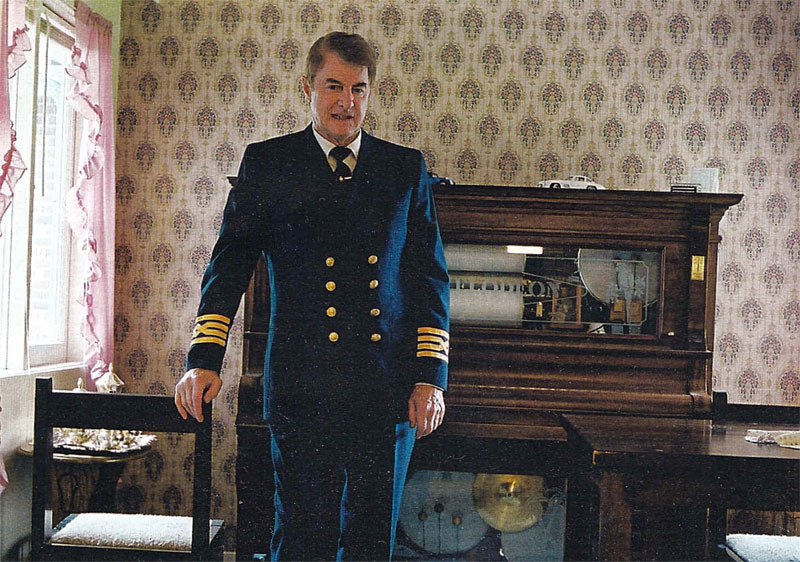
Merchant Navy Chief Engineer Stephen Bentley in 2007. Steve emailed that "The engineers wear a mauve color between the rings. In the background is my player piano. it used to be a single roll player with no other instruments. I installed the instruments and made the controls the play them. I also make the ten tune rolls for these instruments on a perforator I made myself."
Some Reminiscences by Keith Butler.
I would first like to say a posthumous thank you to my shipmate Keith Best for his excellent memories of his time in Gambia [I need to try and find this article] during this commission. Reading his articles has brought back many memories and rekindled some of my own, so I owe it to Keith for showing me the way and I hope the following will also remind others on this commission of the good times that we had. It cannot always be said that a big ship was a happy ship, but Gambia certainly was, and this seems to apply to most if not all commissions judging from all that I have read and heard through the Association.
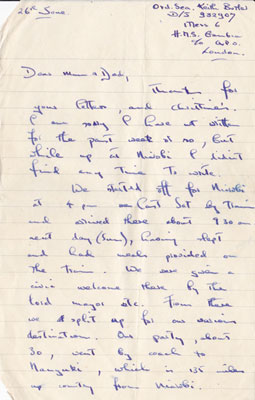
In August 2017, Keith Butler very kindly sent a copy of a letter he sent to his parents dated June 26, 1955. In it he describes a trip he and Steve Bentley made to Nanyuki, about 130 miles north of Nairobi, in Kenya.
Ordinary seaman Keith Butler
D/J 932907
Mess 6
HMS Gambia
CO GPO
London26th June
Dear Mum and Dad,
Thanks for your letter, and Christine's. I am really I have not written for the past week or so, but while up in Nairobi I didn't find any time to write.
We started off for Nairobi at 4pm last Saturday by train and arrived there about 9.30am next day (Sunday), having slept and had meals provided on the train. We were given a civic welcome there by the lord mayor etc. From there we split up for our various destinations. Our party, about 30, went by coach to Nanyuki, which is 135 miles up country from Nairobi.
There we were welcomed at the Silverbeck Hotel, where we were given tea. (We had dinner on the bus). From there we went to the various towns etc. where we were to stay. At first I was with a party who went to say at an army camp. I was there two days Sunday night, now and then. On the Monday we went to Buffalo Springs, which is about 60 miles away; on the way we saw a bit of game and took photographs.
Next day we went up to about 13,000 up Mount Kenya in a Land Rover. We went through the forest round the base, there are some of the big game elephants, and so on, but although we saw plenty of tracks we saw no sign of them. It is of course at Mau-Mau riding area and for this reason and the other we went armed.
On Tuesday evening a friend of mine and myself went onto a farm not far away ; there we had our own room and bathroom, called each morning with a cup of tea etc. Next day (Wednesday) we went into town (Nanyuki) and in the afternoon we tried to repair the generator which provided electricity to the town but as we failed we had to revert to the paraffin lamps. By the way the person who owned the farm was quite an elderly lady you lived by herself, her son is at present Captain of the HMNZN Black Prince, her brother was also a Naval Captain.
Next morning (Thursday) we went on a six mile horse ride with her daughter in law who have the next farm. In the afternoon we went trout fishing in the stream which runs between the two farms, we didn't catch anything.
During the Thursday night a group of Mau-Mau attacked the farm taking a cow. (This was the second attack, she had one on the previous Saturday losing three heifers).
That morning we went out with the trackers to track down the Mau-Mau. It appeared from the tracks that they took all the cattle at first but all but the one managed to get back. We tracked for about 1½ miles when we found the remains of the dead cow. They had taken everything except the intestines and stomach, which said the trackers is very uncommon, as they usually just take the legs, ?????? and rump, leaving the rest. After this the gang (about 10 in number) split up and it was here that we turned back for lunch.
That afternoon we left the farm to join up with the others in the district at the Silverbeck, there we had dinner and then boarded the train for Nairobi. We slept the night on it while it was still in the station at Nanyuki, leaving first thing on Saturday morning. An interesting point about the Silverbeck is that the Equator runs through the middle of the bar.
Saturday 5pm we left Nairobi for Mombasa and arrived here this morning at 9.30am.
Well that's the tale, we leave here tomorrow for Zanzibar so until then I will say cheerio,
Love Keith
P.S. I apologize to Christine for not writing personally but this is too bad as well, will write later to her.
Keith also sent this description of the trip:
Kenya. (14th to 27th June, 1955)
I will start on that train that Keith described taking the ship's Concert Party from Mombasa to Nairobi; as well as the Concert Party there were also about thirty other members of the ship's company on the train, myself included, who were destined to travel on to Nanyuki which is about 130 miles north of Nairobi. This involved a further train journey, and on our arrival we gathered in the Silverbeck Hotel, which sits astride the equator (it runs through the bar and marked with a brass line), to be welcomed by local residents who were to be our hosts, they were mainly local farmers, but some of us were to stay with a Company of the Northumberland Fusiliers under canvas close to the foothills of Mount Kenya. Steve Bentley and I were due to stay on a farm, but the night before we arrived it was raided by the Mau-Mau so this was not possible. We therefore joined the others who were to stay with the Northumberlands.
During our stay with the army, who were there to guard against the Mau-Mau, we went on a safari in an army truck into the Marsabit National Park. As we descended into the Park, past Archers Post, we were able to look north and see the Ethiopian Plateau on the horizon. Once into the reserve we were able to stalk zebras, giraffes and Thompson gazelles. We had our lunch by a pool in which Ava Gardner had swum whilst she was making a film! Our return journey was in the rain and we sang to cheer ourselves up.
Another outing took us up into the foothills of Mount Kenya in Land Rovers to about 14,000ft, after which we walked up another 500ft. I recall that I had been issued with a rifle, with anti-flash muzzle, and ten rounds just in case we came across the Mau-Mau or rampaging buffalo – we didn't!!
Next day Steve and I were told that another farm had offered us a place to stay, and we were duly delivered to the home of Mrs Bullock. She in fact was retired and lived in a bungalow just across the valley from the family farm run by her daughter and son-in-law, Mr & Mrs Whitehead. She also had a son, a Captain RN, then serving on loan with the RNZN. She lived alone, but had a Kikuyu servant, and she kept a revolver in case of a Mau-Mau attack. She had a target on a tree in the garden to keep her hand in with the revolver!! There was a photo of her on the website with her parrot.
Whilst there we tried fly fishing for trout in the stream, no success! And we also went on a horse ride from the farm. Steve had ridden before but I was a complete novice and I had to hang on to the horse's mane for dear life when it decided to follow the others at a full gallop back to the farm.
Our last day there was probably the most memorable. We awoke to the news that the Mau-Mau had raided Mrs Bullock's paddock and driven away the six cows that were grazing there. Most of the cows had returned, but after breakfast a police inspector and two native trackers arrived to try and hunt the Mau-Mau down. Steve and I were invited to join them. At first the tracks were relatively easy to follow with six sets of cow prints; these then dwindled to three sets of prints as cows had escaped from the raiders and made off back to the paddock. After a mile or so we lost all tracks, and like Baden Powell said to do in Scouting for Boys, it was decided that the inspector and a tracker would circle to the left, the other tracker and myself would circle right leaving Steve to stay put. Myself and the tracker eventually found the tracks of two of the cows heading back towards the paddock. We returned to meet up with the others to find no Steve and the Inspector and tracker returning across the field. They had found a barbed wire fence slashed with a panger, usually a sign of Mau-Mau activity. We were debating what to do when Steve turned up having decided to walk on ahead to see what he could find, and find something he did. About 150 yards further ahead he had come across a waterless clay pit across which were the clear footprints of two barefooted men and one cow. We skirted the clay pit and about fifty yards further on found the entrails of one cow. The Inspector told us that the Mau-Mau were now very short of food, hence they had taken all of the cow except the entrails. He also explained that raids on farms had by then become nearly always for food. Lunch time was approaching, and we were leaving the farm that afternoon, so we returned leaving the police to carry on following the tracks.
Later that day, all the Nanyuki contingent met at the Silverbeck Hotel for dinner, generously paid for by our hosts. We learnt that the police had lost the Mau-Mau trail so called off that particular hunt. After dinner we spent the night in the hotel bar singing with our hosts until we boarded the train. We spent the night sleeping in the siding and were served breakfast before the journey to Nairobi where we met up with the concert party for the return to Mombasa.
Keith, in his travelogue, indicates that we went from Mombasa direct to the Persian Gulf. In fact we went from Mombasa to Zanzibar then on to Dar-es Salaam in the then Tanganika before setting off back to Trincomalee, calling in on the Seychelles Islands between 13th and 20th July.
It was not probably common knowledge on board, but the Chaplain, Rev. H W Welsh, had gathered together a few old Boy Scouts and formed a Deep Sea Rovers troop, and arranged a few meetings with local Scout troops in our ports of call. One such meeting was at Zanzibar where we were shown the site of the old slave market and then visited an orange grove (lovely fresh oranges straight off the tree!). There were also clove trees, and we each bit into a clove! An old building on the grove had been taken over by a species of large bats, and the door was gently opened to reveal hundreds of bats hanging from the roof, what a sight for Sir Richard Attenborough.
The stop over in the Seychelles provided lots of opportunities for beach parties and banyans. It should be remembered that we were visiting all these places around the Indian Ocean before the days of package holidays and we had the great benefit of seeing them before they were spoilt by tourism, and all at the expense of HMG.
We crossed the line northwards on the 22nd July at 1000hrs. It was on this crossing that most of the crew were introduced to King Neptune and his court.
I have a record that we sailed a total of 6,315 nautical miles on the trip from Trinco to Mauritius and back via East Africa.
Before setting off for the Gulf, we stayed at Trinco for several weeks, during which time we took part in Exercise JET (Joint Exercises Trincomalee) in which RN frigates from the Gulf, and ships of the Indian, Pakistani and Ceylonese navies participated. We also enjoyed a week's local leave in the tea hills at Diyatalawa.
Persian Gulf
We called in at Colombo for a few days en-route to the Persian Gulf, our next stop being Khor Korwai(?) to drop off mail at the signal station on the Strait of Hormuz, which also gave the C in C ( Vice Admiral Norris), who had his barge rigged for deep sea fishing, to have yet another chance to flex his rods. Incidentally, the C in C caught so many fish, which were stored in the ships deep freeze, that the whole ships company was able to have a fish supper on at least one occasion – that is a lot of fish and included tuna and sword fish.
After further stops at Bahrain and Kuwait we arrived at Basra on the Shatt al-Arab. What a difference between the welcome we received to that more recently experienced by our servicemen and women in the recent Gulf wars. The only shots we fired were blanks in the form of gun salutes, but we made a good show of these, saving them all up for one day, the day we left Basra. (It must be remembered that in those days Iraq was ruled by King Faisal and Iran by the Shah). As we departed from Basra we fired a National Salute to Iraq; later, having moved downstream and across the Shatt, en route to Abadan, we fired a National Salute to Iran. (The Iranian border meets the Shatt about halfway between Basra and Khoramshah) As we passed Khorramshah, we fired respectively 19 gun salutes to the C in C Persian Navy and the C in C Persian Army. A total of 80 rounds in one day. Is this a record I ask? Each salute was of course returned to our C in C, as 15 gun salutes.
During the commission the Chaplain had built up a goodly party of Servers to assist at the daily Communion services held in the ship's chapel. Only when the Chaplain was on local leave was a service not held, could this be another record? As a reward for this dedication the Rev. Welsh organized two trips whilst we were at Basra, both with Biblical connections and both from the Old Testament.
Ur of the Chaldees
Ur is mentioned in the Bible (Gen. 11, 28-31), and is notable as the birthplace of Abraham. Abraham lived during the first half of the 20th century, B.C. though the history of Ur goes back to about 4000B.C. Abraham left Ur and journeyed NW along the Euphrates valley to Harran (near Lake Assad) before turning S into Canaan where he settled for most of the rest of his life.
I was particularly interested in Ur as the first history book we had at school was titled "From Ur to Rome". Ur was excavated over seven years, during the winters from 1922-29, by a combined expedition from the Museum of Pennsylvania and the British Museum led by Sir C Leonard Woolley.
One of the interesting aspects of his excavations was the discovery of an 8 ft. thickness of silt between two layers of ruins. This was an indication of a great flood which was dated as being not later than 3200B.C. Was this Noah's flood? The ark is said to have come to rest on mount Ararat which is in the mountain range from which the Tigris & Euphrates flow.
Our journey to Ur was by two taxis, American limos, and once we were out of the city the main road to Baghdad in those days was just a track in the desert with little or no marking except the odd boulder. If one strayed from the beaten track it was quite possible to get trapped in loose sand, and on the return journey this actually happened to one taxi and we all had to get out and push! At another point the driver pointed out a convoy of army lorries going in the same direction, on the same road, but about half a mile on our port beam. As I remember, they were the only other vehicles we saw going and returning out in the desert.
Shortly before we arrived at Ur we stopped at a road side building that was beside the railway between Basra & Baghdad. Here we were served with tea – no milk, in very small cups. As we approached Ur we stopped at the top of a slight incline from where we were able to see the Ziggurat of Ur a mile or two ahead.
The site was guarded by a lone tribesman in typical Arabic clothes and sporting an ancient rifle. He did not seem too interested in our arrival and did not take any interest in what we did.
The site was dominated by the Ziggurat, which are features peculiar to Sumerian architecture. The Sumerians probably came originally from further east and their bone structure indicates that they were of Indo European stock, similar to Caucasian man. Hence they were likely to have come from a hilly region. As the desert was virtually flat they built artificial hills, Ziggurats, so that they could carry on their tradition of worshipping their gods on high places. There was also a later Ziggurat at Babylon similar to that at Ur, but larger; however that at Ur is the best preserved. Later, in the Hebrew tradition, they became the "Tower of Babel".
At the foot of the Ziggurat was the temple of Nannah the Moon God, which formed the main entrance onto the Ziggurat, which was originally topped with a tower. The complete structure measures about 200 x 150 feet was originally 70 feet high. It is a solid mass of brickwork, the core being unbaked brick and faced with an 8 feet thickness of baked brick set in bitumen.
We scrambled around the excavations looking at the remains of houses, including some from the time of Abraham, the temple of E-Nun–mach and the Temenos Wall of Nebuchadnezzar, king of Babylon from 605-562 B.C. Most of us picked up bits of pottery, nothing complete, only shards, but it is interesting that the better pottery that was painted came from the excavations beneath the flood silt mentioned above, and therefore the oldest. That from above flood silt was unpainted and coarser. It is assumed that the flood partially, if not totally, destroyed the city, thus losing the craftsmen and tools that they had developed over many centuries. The best find was made by Leading Seaman Jan Savage, who found a small image, or miniature god, about six inches tall. I seem to remember that we all wrapped our finds in the packed lunch bags just in case the guard took an interest!
Ur was abandoned about 300BC following the establishment of the Persian empire in the region. At the time described above Ur was sited on the banks of the Euphrates, now it is about ten miles south of the river.
My memory is a bit hazy now as to who actually went on this trip, but I remember that as well as the Rev. Welsh there was also the ships two "schoolies", Lt. Cdr. H W Wright, Lt. Cdr. P O Stanley, L. Sea Jan Savage, Writer John Pedler, as well as myself. There are possibly two others, anyone any ideas?
I have recently read a book entitled "Battles on the Tigris" by Ron Wilcox (ISBN 1 84415 4300). This is an account of the 1914-18 War in Mesopotamia as fought by the British and Indian Armies, supported by the RN in river craft on the River Tigris. The conditions were atrocious and the casualties of this part of the war only make the recent involvement of our forces in Iraq seem minimal by comparison. If I remember from the book correctly there were about a dozen VCs awarded, some to RN personnel. I can recommend this book for its factual detail and maps of the battlefields and river sections.
I also found it interesting that one of the problems of fighting in this area were the floods that were caused by the Tigris and Euphrates bursting there banks following local heavy rain and melting snow in the mountains where the rivers have there source. These problems have now been solved by dams that regulate the flow, but it is indicative of the flooding problems that would have caused the great flood of which Sir Leonard Woolley found evidence.

Padre's visit to Ur of the Chaldees, Iraq. This is the Biblical site of Abraham's birth. Image from Keith Butler
Keith and his friends took a trip in two taxis here.
The excavations were made by Sir Leonard Wooley, and this shot is of King Nebucanezer's wall.The Garden of Eden
The visit to the Garden of Eden was made by a small river boat hired for the occasion by the Chaplain, and again involved an early start. The Garden of Eden is located at the confluence of the Tigris and Euphrates Rivers at a place called Al-Qurnah, a distance of about forty miles.
The Shat-el Arab remains quite wide all the way to Al-Qurnah but we took a course close to the western bank which enable us to see some of the life and work being carried out on the fertile river land adjoining the river. There were irrigation channels reaching into the farmland, houses were very few and primitive by Western standards. Palm trees abounded and every so often, what appeared to be very basic brick kilns could be seen using the local clay. We were also fascinated by what appeared to be floating hayricks moving downstream on the current. They were in fact barges carrying reeds to a height of about twelve feet or more, manned by two or three crew who sat on the top of reeds! They did not seem to have much control of there destiny, but no doubt the had been doing the same thing for centuries.
We arrived at Al-Qurnah at about 11.30 and landed directly into the small area then kept as the Garden of Eden from the west bank of the Tigris. It measured about 10 x 30 yards and comprised of a grassed enclosure with three or four fruit trees growing in a line and alongside them the dead trunk of another tree. These trees were reputedly direct descendants of the tree from which Adam picked the fruit to give to Eve!! The dead trunk is reputedly the remains of the tree from which Adam picked the fruit!!!! Incidentally the fruit was not an apple. At the time we visited (November) the fruits were only about the size of a damson, but green, and I imagined that when they were full grown they would have been something akin to a plum.
It did not take too long to complete this sight seeing so we started to explore the rest of the "city". We followed the main street where there was a busy fruit and vegetable market in progress. At the far end of the street, probably half a mile away from our landing place, we came across a large and substantial building with an Iraqi flag flying from a flagpole. Our curiosity was raised, and someone, who shall be nameless suggested that the flag would make an excellent trophy! There did not appear to be any one around so two of our group went through the gates towards the flagpole which was about 20 yards from the gateway. Just as they were nearing the flagpole, a man appeared round the corner!
He was the Head Master of the school that the building turned out to be. The strategy was changed in a flash, and expressed our curiosity in the building whereupon the Head invited us in and showed us around. We of course explained our reason for visiting Al Qurnah and he then produced a large map, in Arabic, of the British Isles and hung it on the wall. He then went round us all in turn asking us to point to where we lived. He then translated the Arabic into English, and if we were lucky, or our geography up to scratch, we heard the name of our home town. (Fortunately, I managed "Stafford" first time.)
At about this time school finished for the day, and after our thanks and farewell to the Head we were accompanied by a goodly number of the pupils back to the Garden of Eden where one young lad produced a penknife and proceeded to carve us all a piece of wood from the tree from which Adam had supposedly picked the fruit for Eve!! We then boarded our boat and proceeded down stream to Basra and HMS Gambia.
Keith emailed me again in October 2018 and went over some of this again with some new details:
I remember our time in the Gulf. It was In Bahrain that we took on some awful water that turned "Daz" into something resembling wallpaper paste. The poor old stokers had to clean to the fresh water tanks before relying on our own evaporated seawater. I think it was at Calcutta that there were dead cow, sacrificed to the Ganges on death, that rendered the evaporated seawater unfit to drink.
The other thing I remember of Calcutta was an afternoon at the races and evensong in the cathedral followed by a soiree at the bishops palace where we sang around the grand piano. Back to the Gulf, when Iraq had a king and Iran a Shah, we again enjoyed excellent hospitality. I visited the garden of Eden and Ur from Basra and in Abadan the ship was challenged to an athletics contest by the refinery. I recall throwing the javelin against the guy who had represented Iran at the Olympic games in 1952!
Keith also very kindly sent the following photographs for the site:
Julian Best sent the following picture to Bill's original site. He was an LME on this commission.
Christmas was spent in Trincomalee, Sri Lanka (then named Ceylon) and their Christmas day meals looks delicious.
The image below was very kindly supplied by John Aire's daughter, Amanda Dalton...
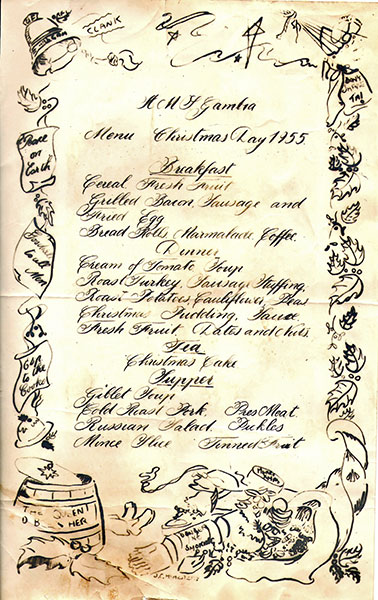
The photo below was supplied by Inst. Lt. Cdr. Paul O. Stanley and is of the cooks stirring the Christmas 1955 pudding.
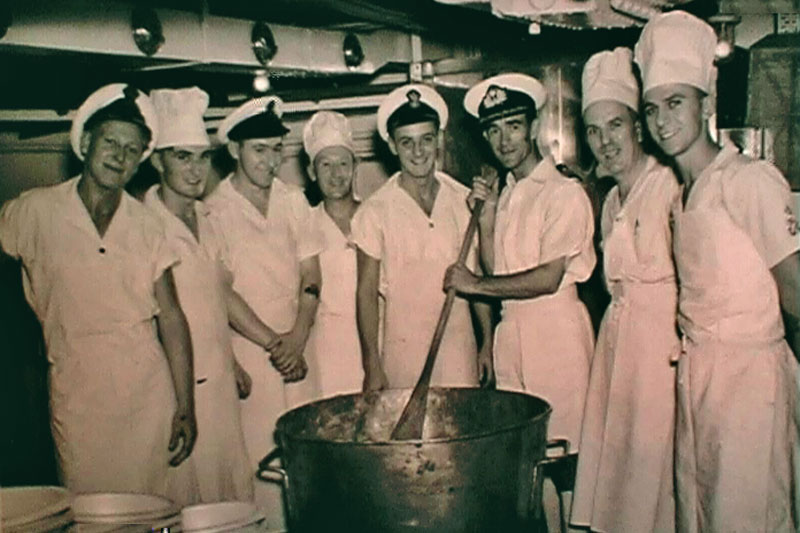
Pictured above, from left to right: Ck Morrisey, Mne Ck Whitehead, Ck Jenkins, P.O. Ck Ford, P.O. Ck Bennet, Cdr Trythall, C.P.O. Ck Heath, P.O. Ck Newell.
Julian Best also sent the following information and image for Bill's original site:
The text from this newspaper clipping reads:
SHIP THAT FIRED WAR'S LAST SHOT NOW IN CALCUTTA
By a Staff Reporter
HMS Gambia, flagship of the East Indies Station, at anchor at the Man-O-War Jetty where it arrived on Saturday morning. The ship is paying a short visit to Calcutta. – Statesman.
The 8,000-ton British cruiser HMS Gambia, flagship of the East Indies Station, arrived in Calcutta on Saturday on a six-day visit to the city. The cruiser, which was due in Calcutta on Friday, was delayed at the mouth of the river for 24 hours by fog.
HMS Gambia was built during World War 11 and from the time of her completion in 1942 till January 1948 she served with the Eastern and British Pacific Fleets. Her war-time record was not particularly spectacular. She claims, however, to have fired the last shot of the war — a claim which has so far not been disputed.
Here is the story as told by Captain W. Evershed, her present commander. On the last day of the war she was somewhere in the Pacific between Okinawa and Japan. Two minutes after the official "cease-fire" was due to have come into force her captain, now Admiral Sir Ralph Edwards, Third Sea Lord, went to the ship's loudspeaker system and said, "Gentlemen, the war is over. You may now stand down from your guns" in the correct naval parlance of course for such an occasion.
He had barely finished speaking, however, when his Gunnery Officer rushed up and said, "No, sir. You can't do that. Look." And he pointed to the sky where a kamikaze pilot was diving at the ship in a suicide plane. The order to open fire was immediately given and the plane was shot down before it reached the ship. That is how HMS Gambia claims to have fired the last shot of World War II.
HMS Gambia only came out to the East Indies Station last May, having, for two years before this, been with the Mediterranean Fleet. During that time she had the distinction of taking to England on his State visit, the Emperor of Ethiopia.
Princely Midshipman
The Emperor's grandson, prince Alexander Desta, is at present serving as a midshipman on the cruiser though in the words of Admiral C. F. W. Norris, the Commander-in-Chief, he is known as plain Midshipman Desta and he is treated like any other "snotty."
Almost the first to visit the cruiser she had tied up at her moorings was a party of reporters. Addressing them in his cabin Admiral Norris, who has just been created a knight in the New Year Honours' list, referred to what he described as "a very satisfactory exercise" held at the end of July in which four Commonwealth Navies – Britain, Ceylon, Pakistan and India had taken part.
The exercise had included not only surface vessels from the four navies but also submarines of the Royal Navy and long-range aircraft from Singapore and Gibraltar.
One of the positive benefits of such an exercise, he said, from the naval point of view was that it gave the various navies taking part the great benefit of working with a lot of ships which it seldom possible for them to do on their own. There were also the very important aspects of ship-air liaison and the hunting of "live submarines."
Over and above all this, however, Admiral Norris maintained was the spirit of cooperation between the Commonwealth Navies in work and play, which these annual four week exercises helped to breed.
In reply to a question as to what differences in the design of a cruiser might arise if protection was to be afforded against atomic warfare, Captain Evershed said that it was just as easy and infinitely cheaper to destroy a cruiser by a torpedo attack than with an atom bomb. In the case of a fleet, the answer was dispersal of the vessels which would make it virtually impossible to destroy all the ships in one attack.
Agreeing with this, Admiral Norris added that he would much prefer to be at sea than in a big city like Calcutta in the event of an atomic war. Even after an atomic attack it was easy at sea to wash away all vestiges of radioactive dust. This was not possible in a big city.
This postcard picture of the Howrah Bridge over the Hooghly River, Calcutta, was contributed by Andy Andrews, Julian Best or Keith Butler:
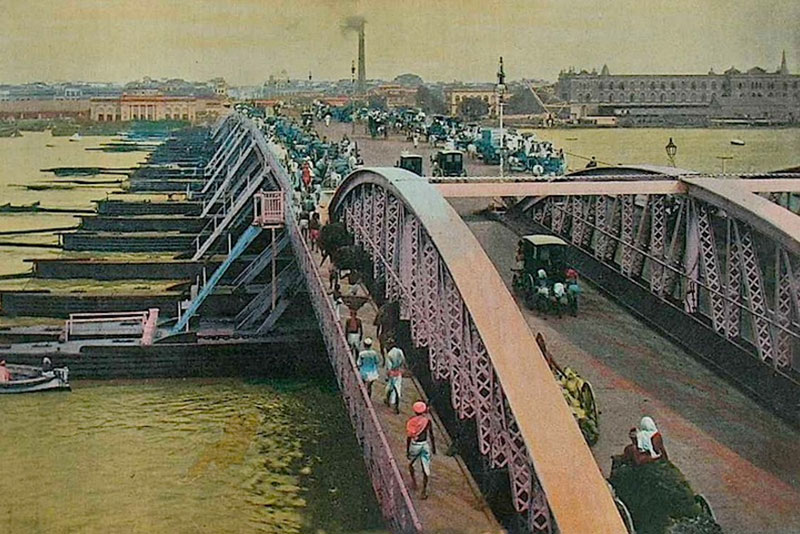
Bill's original site has the following concerning the river "Remember when we were anchored in the river Hooghly in Calcutta? When we had to shut the 'evaps down, because the water was contaminated, people living on the bridge that was up river to us used to throw anyone who died, into the river, they put garlands round the neck of the corpse before throwing it into the river, I wondered what all those vultures were sitting in the trees for! Well I'm pretty sure this is the bridge, and you can see the huts on the far side of it."
Steve Bentley confirmed this story saying a friend of his, a leading stoker on the Gambia, main duties was to look after the equipment to make fresh water from the seawater. The only time he did not make "fresh" was in Calcutta in the Hooghly river as there were a few dead bodies floating past the ship each day!!
In July 1952, Boy Sailor Keith Best started the application process to serve with his brother Julian who was on HMS Devonshire at the time:
More from Julian Best. Left to right back row: Julian Best, Keith Best, front row left to right Scouse McCarten and Brum Harris. Julian is the last survivor from this quartet.
I can't find Keith Best in the list of crewmen in the 1995-56 Commission Book but there is a M(E) W. H. McCarten. There are several Harris's in the list among them M(E) B. G. Harris, M(E) R. Harris, and L.M.(E) J. A. Harris.
I don't think the man pictured is the last named or there would have been an "L" under the propeller insignia on his arm. Julian informs me that I am mistaken is saying this, he never saw one of the "L"'s - he should know, he was there, I was not.
Julian Best and the late Keith Best with others, so who are the other two? Julian can't remember them.
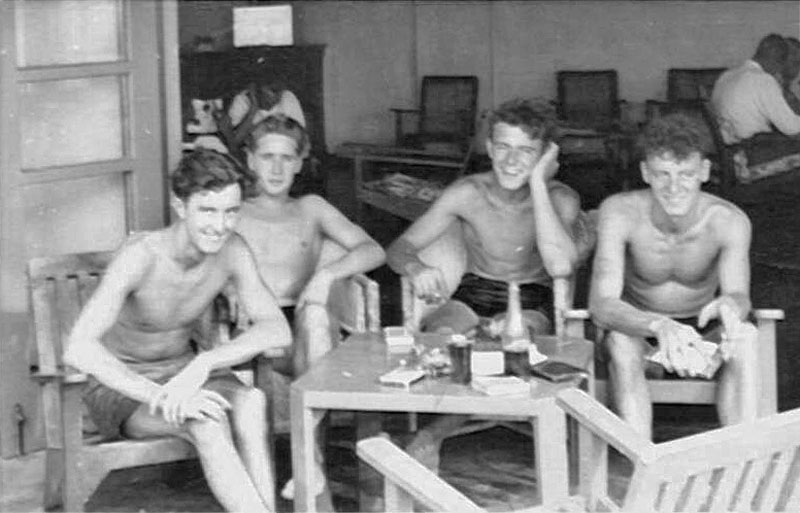
This is a much later photograph of Julian and Keith Best. This was taken in April 1962 and used on Bill's original site by permission of Sheila Best.
Keith Best was in the Royal Navy from November 1950 to April 1960. He wrote the story of his life in the navy for his family and in October 2019, his brother Julian gave me permission to add some illustrations and present it here:
This photo was contributed by Andy Andrews, Julian Best, Keith Butler or Paul Stanley. Unfortunately I do not know which of them it was. The picture is of Bob Garnett and Mac Simonds. According to the Commission book, this would be M(E)s R. G. Garnett and A. J. Simonds.
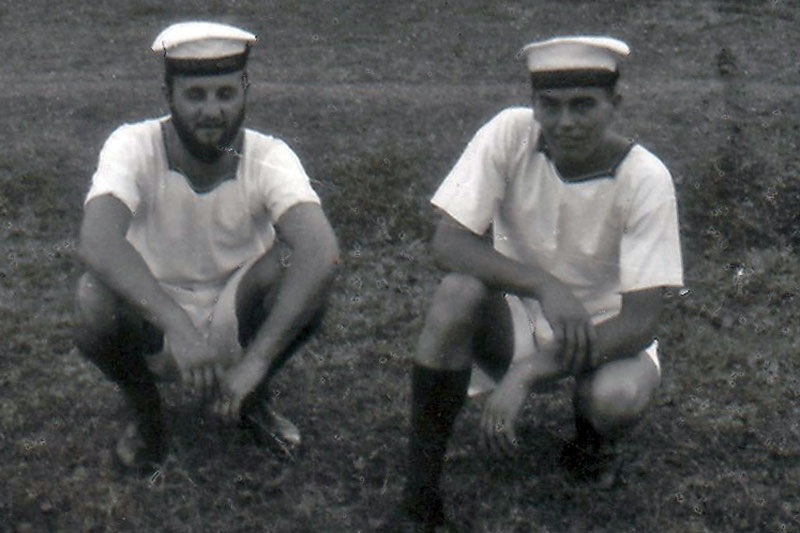
This lush jungle scene was taken by Julian Best. He said it was taken either at Colombo or Diyatalawa in Ceylon. "I meant to take a photo of some elephants working alongside the road, but I wasn't quick enough with the camera!"
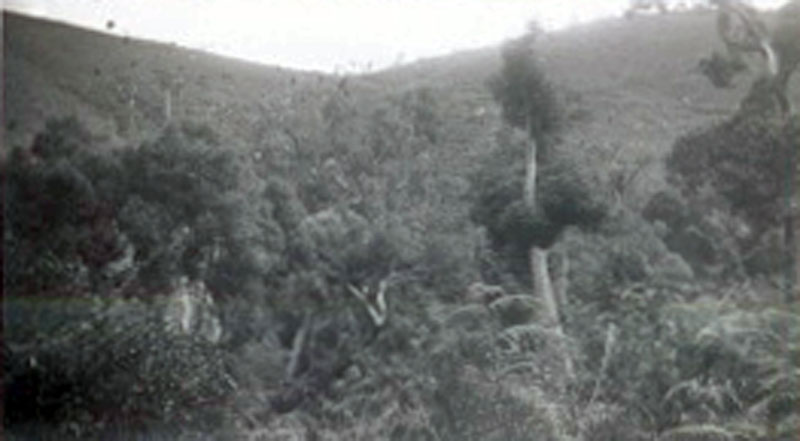
Royal Marines
Below: The Royal Marine band for the 1955 to 1956 commission. This photo was sent to the HMS Gambia Association by Ron Mackay, who is pictured on the extreme right of the second row. Sadly, Ron has now "crossed the bar."
From left to right in the above photograph:
Back row: Pete McRoy, John Bradshaw
Third row: Ron McCallum, Dips Hillman, Pip Phillips, Ron Kempton, Terry Parker, Harry Henshaw, Eric Hayward, Frank Tomlin.
Second row: Ken Keast, Dennis Swan, George Brooks, Brian Oates, Neil Ashley, Peter Redfern, Dimps House, Vic Asher, Ron Mackay.
First row: Cpl Brown, Ted Lee, Little Joe, Staff Bandmaster Graham Shipway, B/Sgt Ray Banning, B/Cpl Buster Elver. There appears to be a name missing for the front row.
[The Commission Book lists Swann and Howse rather than Swan and House]
Below: The Royal Marine band mess in August 1955:
This image also appears on the Royal Marine Band Service website and some of the bandsmen have been identified.
From left to right: Frank Coleman - ?? - Paddy Fullerton - Bill Bailet - ?? - ? Silcox - ?? - ?? - Harry Kershaw - Tex Tyler - ??
This image was supplied by Royal Marine bandsman Dave Webster and is of the band mess in August 1955:
The bandsmen in the above image are identified as left hand table row back to front: Brown, Bailey, Haley. Middle row, back to front: ?, Douglas, Tubb, Fullerton, Compson. Right hand table row, back to front: Snell, ?, Tyler, Walton, Jenkins.
Another picture supplied by Royal Marine bandsman Dave Webster and is of the "Gambia Band" at Diyatalawa Rest Camp, Ceylon (now Sri Lanka) in 1955:
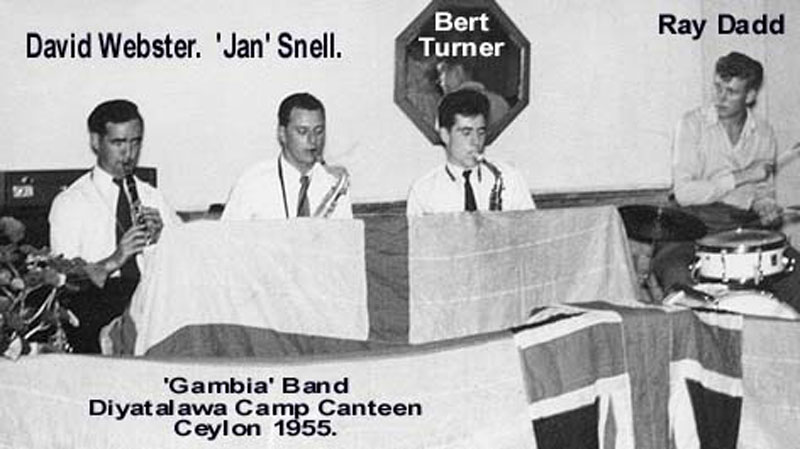
Pictured above are Dave Webster, Jan Snell, Bert Turner and Ray Dadd.
Pictured below is the C in C East Indies Band 1956, broadcasting from the studio of Radio Bahrain.
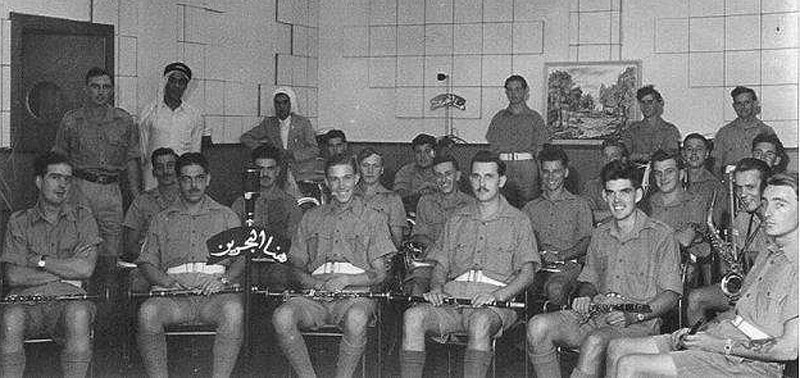
Pictured above are:
Back row, standing from left to right: B/M Graham Shipway, two unknown Arab technicians, seated Frank Tomlin, Vic Asher, standing Eric Hayward, Brian Oates, Pete Howse
Centre Row: Ted Lee, Ray Banning, Pete Redfern, Neil Ashley, Dennis Swann, Ron Kempton, Ron McKay, Pete McRoy, Ron McCallum
Front Row: Terry Parker, Buster Elver, Harry Henshaw, Dip Hillman, Jim Phillips, Sailor Brown, George Brookes.
Ian Epps (a typo in the Commission Book?) and Frank Coleman give an account of their time on Gambia on the Royal Marine Band Service website and subsequent pages on that site.
The 1955/6 Commission Book lists the RM Bandsmen on Gambia at the time as:
S. B. Mtr. R. R. Winchester, B. Sgt. R. D. Jewell, A/B. Cpl. A. W.(Bill) Bailey, A/B. Cpl. R. K. Browny and musicians J. D. (Jim) Bishop, D. J. (Lofty) Clark, F. E. (Frank) Coleman, P. R. Compson, B. G. P. (Brian) Douglas, J. [I.?] B. (Ian) Epps, R. A. (Efty) Fowler, W. (Paddy) Fullerton, L. A. (Titch) Haley, L. (Len) Hart, L. M. Jenkins, D. E. (Harry) Kerslake, G. J. Silsox [Silcox?], K. O. Smith, D. (Jan) Snell, G. Tubb, R. (Bert) Turner, J. D. W. (Tex) Tyler, G. T. (Wally) Walton, and D. A. (Dave) Webster
and:
S. B. Mtr . G. G. (Graham) Shipway, B. Sgt. R. (Ray) Banning, B. Cpl. (Buster) Elver, A. B. with musicians N. (Neil) Ashley, V. C. (Vic) Asher, J. M. (John) Bradshaw, G. (George) Brooks, J. W. (Dips) Hillman, P. E. (Dumps) Howse, N. F. (Harry) Henshaw, E. C. (Eric) Hayward, R. J. (Ron) Kempton, K. (Ken) Keast, R. J. (Ted) Lee, R. M. (Ron) MacKay, R. (Ron) McCallum, P. R. (Pete) McRosy [McRoy?], B. (Brian) Oates, T. W. (Terry) Parker, J. H. (Pip) Philips, P. (Peter) Redfern, D. B. (Dennis) Swann, and F. S. (Frank) Tomlin
I do not know why there are two lists. They may have been different watches or messes?
Stokers
The photo below was supplied by Inst. Lt. Cdr. Paul O. Stanley and is of the 2nd starboard stoker watch.
1955 Hockey Team
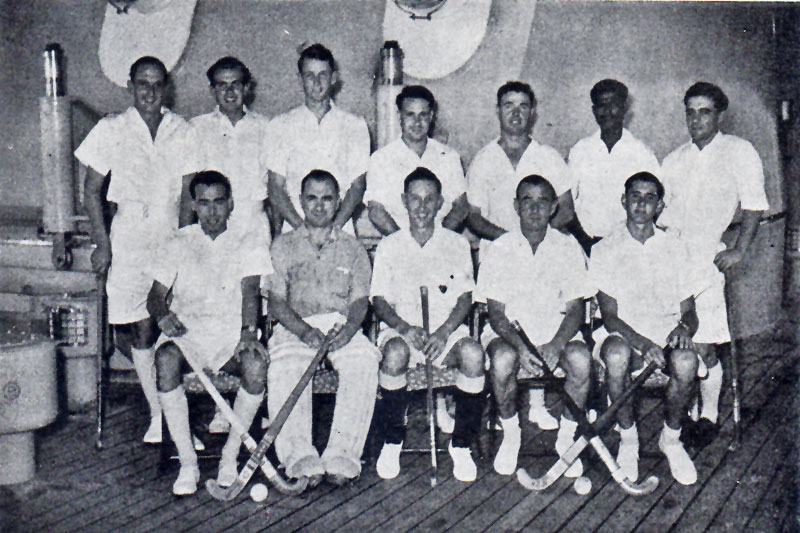
Inst. Lt. Cdr. Paul O. Stanley identified most of the HMS Gambia's hockey team of 1955. Back row, left to right: Smith, Caralet, unknown, unknown, Ali, Davies. Front row, left to right: Palmer, Knowling, Stanley, Smith, Bowyer-Tagg.
There were around a dozen Smiths on the 1955/56 commission so I couldn't identify them further. The only ones I could identify further were G. C. Bowyer-Tagg who was a midshipman and P. C. Knowling who was a Stores Chief Petty Officer (V).
HMS Gambia returned to Devonport Dockyard on March 1, 1956. Before ships arrived home, invitations were sent to parents and next of kin to greet the crew. This invite was to Mrs. Rees, mother of Julian Best.
Julian also sent Bill the newspaper clipping. The text from this newspaper clipping reads:
HOMECOMING OF H.M.S. GAMBIA
RELATIVES WERE UP BEFORE DAWN IN PLYMOUTH
Lights went on early in many Plymouth houses today when relatives and friends of men in the cruiser H.M.S. Gambia, which arrived No. 1 jetty. Devonport Dockyard, arose to greet them home.
From 6.30 a.m. some relatives began to arrive at the Fore-street gate although they knew they would not be admitted until an hour later.
Commenting on the cruise, which had taken them to nearly 20 different countries, Capt. Evershed said he was astounded at the hospitality accorded to both officers and men.
In pre-war days, he said, the East Indies Station had a reputation for being hospitable to officers only. But during the last 12 months every member of the ship's company had had invitations to functions ashore at every port of call.
This story was originally sent to Bill by the Late Bob Buckley. Stephen Bentley also remembers this incident because he was one of the few crew who was on the ship in Rosyth at the end of the commission in March 1956.
Fireworks over the Forth
I don't know how many six-inch shells the average ammunition lighter can hold. But I imagine, at full capacity, enough to put on quite a firework display if they all happened to explode at the same time. That being the case, the citizens of Rosyth narrowly missed a grand treat when the Gambia de-ammunitioned just upstream from the Forth Bridge back in March 1955.
Serving as a Boy Seaman on the Gambia, I was detailed as lighter party for 'B' turret when the ship was de-ammunitioning in prior to entering the dockyard for refit at the end of the 1954-55 commission. As most you ex-matelots will know, during de-ammunition, the shells were brought up to the upper deck by the turret's hoist mechanism, then lowered into the lighter by derrick.
So there we were, frantically stacking the shells into neat rows, four or five deep, as they rapidly lowered into the lighter by cradle. As the work progressed, the available deck space grew less and less until, to get to the only deck space available, we had to drag the cradle a considerable distance sideways before it could be lowered.
By the end of the day, I think everyone involved was getting pretty chokka with it all the heavy work. Maybe the thought of pints of the McEwans Heavy Bitter on offer ashore was occupying everyone's minds. That, or Pink Gins. Especially the mind of the Sub-Lieutenant in charge of the derrick's operation. "Hoist away," he commanded, as we lifted the last shells from the cradle. But he wasn't concentrating was he? Because the cradle swung in a great arc, and one of the hooks of the cradle's caught on the rope that ran around the rubbing strake of the lighter's dinghy, that stood in front of the wheelhouse. Up came the dinghy, swaying backwards and forwards above us, as we gazed upwards in dismay. Crack! The rope broke and we dived for cover as the dinghy crashed down, scattering six-inch shells in all directions.
Just how much ill-treatment a six-inch shell can take, I do not know. But we thought the end had come. Strangely enough, apart from being ordered to re-stack the shells, nothing else was ever said, no apologizes were made (as far as I know), and no enquiry was ever undertaken. Just how close we came to total obliteration that day, I do not know. Perhaps only the shells themselves could have told us.
[Note: Stephen insists this happened in March 1956, not as Bob described it in March 1955. The reason Stephen is adamant on this is because he was on board as they were preparing to start the 55/56 commission sailing from Plymouth on April 1. He was also on board at the end of the commission going up to Scotland in March 1956 where they unloaded all the ship's ammunition prior for a refit]
Chinese ABCD Cafe
The Chinese ABCD cafe was on Dockyard Road, Trincomalee, Sri Lanka and catered to foreign visitors - especially British sailors. It might even still be there because on March 19, 2013, in an article that appeared in both the Colombo Telegraph and the Daily FT, Charitha Ratwatte wrote that "The iconic Chinese-owned ABC café at the entrance to SLNS Tissa, and its specialty of iced lime juice soda, is an unforgettable experience." He also wrote that "Trincomalee was a huge British naval base. Members of the Chinese community domiciled in Trincomalee today are said to be descendants of the laundry men the British Navy inducted from Hong Kong to service the base."
On February 4, 1948, Ceylon was granted independence as the Dominion of Ceylon. Dominion status within the British Commonwealth was retained until May 22, 1972 when it became a republic and was renamed the Republic of Sri Lanka. The huge naval and air bases were take over by Sri Lanka in 1957, and today SLNS Tissa and SLN Dockyard are used by the Sri Lankan Navy.
The above menu, dated February 27, 1956, was very kindly donated by Janet Kirkham, niece of Sick Berth Attendant Kenneth George Griffin.
Bill had a lot of images on his website, unfortunately all that could be retrieved from the Web Archive were the thumbnails. Until the original photographs can be found they are simply presented here.
This set of photos is a mixture that came from Andy Andrews, Julian Best and Keith Butler.
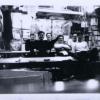 Andy Andrews is the one in a black jumper
Andy Andrews is the one in a black jumper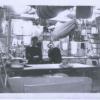 Andy Andrews in a hammock
Andy Andrews in a hammock Group Mess
Group Mess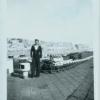 Small Smiler Malta 1953
Small Smiler Malta 1953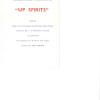 Concert Party program
Concert Party program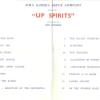 Concert Party program
Concert Party program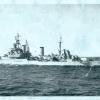 Gambia at Sea 1954-1955
Gambia at Sea 1954-1955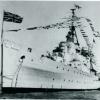 Spithead 1953 Dressed Overall
Spithead 1953 Dressed Overall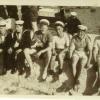 Sports Day 1953
Sports Day 1953 This is the list of names that appear in the previous picture.
This is the list of names that appear in the previous picture. Barraca Lift Head, now dismantled
Barraca Lift Head, now dismantled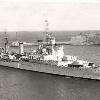 HMS Kenya
HMS Kenya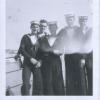
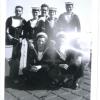
Inst. Lt. Cdr. Paul O. Stanley (Instructor Lieutenant Commander with 8 years' seniority?) sent Bill a set of photographs from this commission. Unfortunately all I could retrieve were the thumbnails from his original site and those are presented here as they are.
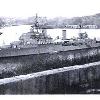 HMS Gambia in Malta
HMS Gambia in Malta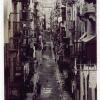 Strait Street, Valletta, Malta. This was also known as "The Gut"
Strait Street, Valletta, Malta. This was also known as "The Gut"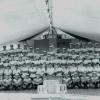 Quarterdeck Division 1955
Quarterdeck Division 1955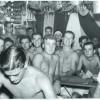 10-11 Mess 1955
10-11 Mess 1955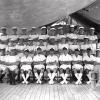 Stokers Division 1955 - 1956
Stokers Division 1955 - 1956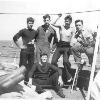 The Electrical Messdeck. Electrical Mechanic, Tommy Geoghegan is sat on deck but the others are unidentified
The Electrical Messdeck. Electrical Mechanic, Tommy Geoghegan is sat on deck but the others are unidentified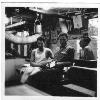 The Electrical Messdeck with hammock slung in background
The Electrical Messdeck with hammock slung in background Royal Marines Band departing for Embarkation from Deal, Kent Railway Station
Royal Marines Band departing for Embarkation from Deal, Kent Railway Station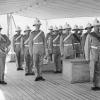 Royal Marines Band
Royal Marines Band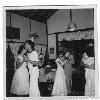 Bride of Electrical Mechanic, Tommy Geoghegan
Bride of Electrical Mechanic, Tommy Geoghegan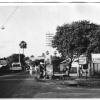 Trincomalee, Sri Lanka. The dockyard gates
Trincomalee, Sri Lanka. The dockyard gates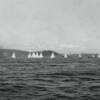 Sailing dinghies escort HMS Gambia out of Trincomalee Harbour, Ceylon
Sailing dinghies escort HMS Gambia out of Trincomalee Harbour, Ceylon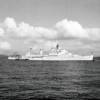 HMS Gambia pre-departure
HMS Gambia pre-departure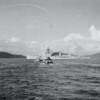 HMS Gambia on her way
HMS Gambia on her way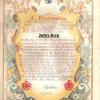 Neptune's Certificate for Crossing the Line.
Neptune's Certificate for Crossing the Line.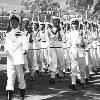 Queens Birthday Parade, Mauritius June 1955
Queens Birthday Parade, Mauritius June 1955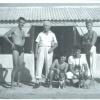 Grippo with Sir Roger Thomas, Karachi, Pakistan
Grippo with Sir Roger Thomas, Karachi, Pakistan
A grippo was a free run ashore, drink or meal. Usually in a foreign port.
As far as I know this is the Sir Roger Thomas that is referred to: Sir Roger Thomas (1886-1960), pioneer of modern agriculture in India. Indian Agricultural Service, Madras 1913, serving in Mesopotamia 1917-25; Managing Director, Sind Land Development Company 1932-60; Agricultural Adviser to Government of Sind 1944-52; member, Pakistan Agricultural Enquiry Committee 1951-52; chiefly relating to agricultural and development planning in Sind, Pakistan and India.
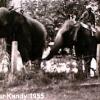 Working Elephants in Kandy, Ceylon
Working Elephants in Kandy, Ceylon Diyatalawa Rest Camp, Ceylon. Steve Bentley who is pictured standing 2nd from left gave names to the people in the image. 3rd is Peacock, 4th is Pritchard 5th is a civvy wearing Steve's Cap and 6th was a Danish Hoogli river pilot.
Diyatalawa Rest Camp, Ceylon. Steve Bentley who is pictured standing 2nd from left gave names to the people in the image. 3rd is Peacock, 4th is Pritchard 5th is a civvy wearing Steve's Cap and 6th was a Danish Hoogli river pilot.
From the Commission Book: Steven L. Bentley and D. Pritchard were Electrical Mechanics, S. L. Peacock was a Leading Electrical Mechanic.
From Wikipedia: The Hooghly River (Hugli; Anglicized alternatively spelled Hoogli or Hugli) or the Bhāgirathi-Hooghly, called "Ganga" traditionally, is an approximately 260-kilometre-long (160 mi) distributary of the Ganga river in West Bengal, India. It splits from the Ganges as a canal in Murshidabad District at the Farakka Barrage. The town of Hugli-Chinsura, formerly Hooghly, is located on the river, in the Hooghly district). The origins of the Hooghly name are uncertain, whether the city or the river was named first.
 Rest Camp Transport, topping up before the radiator dies.
Rest Camp Transport, topping up before the radiator dies.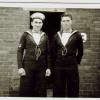 AB F. P. A. Perkins on the right. The sailor on the left is unnamed.
AB F. P. A. Perkins on the right. The sailor on the left is unnamed.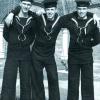 The names of these three sailors is unknown
The names of these three sailors is unknown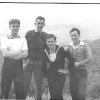 The names of these four sailors is unknown
The names of these four sailors is unknown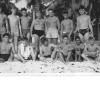 Electrical Messdeck on a banyan.
Electrical Messdeck on a banyan.
Banyan Days were introduced during the reign of Queen Elizabeth I to economize on the cost of meat, where fish or cheese were issued on banyan days in place of salt meat. The term originates from the "banian", a garment worn by an East Indian sect who neither kill nor eat meat. The term is now used for a kind of navy party. They are fun occasions held outdoors with the emphasis on good food, good drink and good friends.
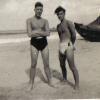 No idea who or where
No idea who or where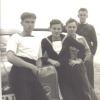 No idea who or where
No idea who or where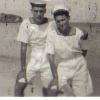 No idea who or where
No idea who or where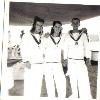 Reed on left, Colin Andrews in middle and Alf Baguley on right
Reed on left, Colin Andrews in middle and Alf Baguley on right
From the Commission book that would be AB, E. Reed; Ordinary Seaman, C. Andrews; and AB Alf Baguley.
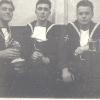 Colin Andrews and Jimmy Swan and an unknown
Colin Andrews and Jimmy Swan and an unknown
From the Commission Book, that would be Ordinary Seamen, C. Andrews and J. M. Swan
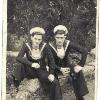 This was originally captioned as Colin Andrews and Jimmy Swan in Aden. Steve Bentley contacted Bill and said that the only time Blues were worn was in Malta or the River Section up the Gulf, never in Aden.
This was originally captioned as Colin Andrews and Jimmy Swan in Aden. Steve Bentley contacted Bill and said that the only time Blues were worn was in Malta or the River Section up the Gulf, never in Aden.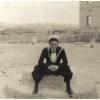 Ordinary Seaman, Colin Andrews in Malta
Ordinary Seaman, Colin Andrews in Malta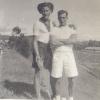 ABs, E. Reed and D. I. Boorman
ABs, E. Reed and D. I. Boorman Christmas 1955 on the Messdeck. Middle Row 2nd from left is Jock Menzies, extreme right is 'Oggie' Brown and in front of 'Oggie' Brown is Jock Aire.
Christmas 1955 on the Messdeck. Middle Row 2nd from left is Jock Menzies, extreme right is 'Oggie' Brown and in front of 'Oggie' Brown is Jock Aire.
From the Commission Book these named sailors were probably Telegrapher, W. Menzies and Leading Telegrapher, J. W. H. Aire.
 HMS Gambia
HMS Gambia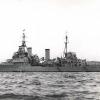 HMS Gambia at anchor, but location unknown
HMS Gambia at anchor, but location unknown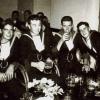 The names of these sailors is also unknown. Stephen Bentley says it was more than likely taken in Abadan on a grippo. He says it could not have been taken in Calcutta as it was warmer than usual while they were there and wore half blues. It also could not have been taken in Malta as it was rare to have group photos taken there.
The names of these sailors is also unknown. Stephen Bentley says it was more than likely taken in Abadan on a grippo. He says it could not have been taken in Calcutta as it was warmer than usual while they were there and wore half blues. It also could not have been taken in Malta as it was rare to have group photos taken there.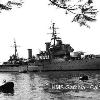 HMS Gambia at the Hoogly River mooring, Calcutta
HMS Gambia at the Hoogly River mooring, Calcutta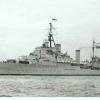 Keith Butler suggested to Bill that this looks like it was taken on entering Devonport at the end of the Commission, prior to departure for Rosyth for paying off.
Keith Butler suggested to Bill that this looks like it was taken on entering Devonport at the end of the Commission, prior to departure for Rosyth for paying off.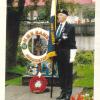 Frank Farmer at Liverpool, when Frank was the Standard Bearer for the HMS Gambia Association.
Frank Farmer at Liverpool, when Frank was the Standard Bearer for the HMS Gambia Association.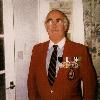 Ted Burnell ex Royal Marines, picture submitted by George Macavoy
Ted Burnell ex Royal Marines, picture submitted by George Macavoy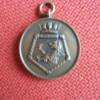 Diyatalawa Medal
Diyatalawa Medal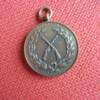 Diyatalawa Medal (reverse)
Diyatalawa Medal (reverse)This set of photos came from Dave Webster. According to the Commission Book, there was a musician of the Royal Marine Band named D. A. Webster. Unfortunately all I could retrieve were the thumbnails from Bill's original site and those are presented here as they are. There is also no descriptive text with them.

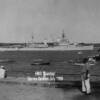
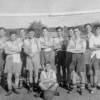
As well as HMS Gambia, Dave also served on her sister ships, Kenya and Newfoundland.
Sources
Banyans - Esquimalt Naval & Military Museum
Dave Axford's Commission Book for 1952 - 1954
Dave Axford's Commission Book for 1955 - 1956
Mombasa European Primary School (MEPS)
Royal Marine Band Service
Thomas, Sir Roger - Dictionary of Welsh Biography
